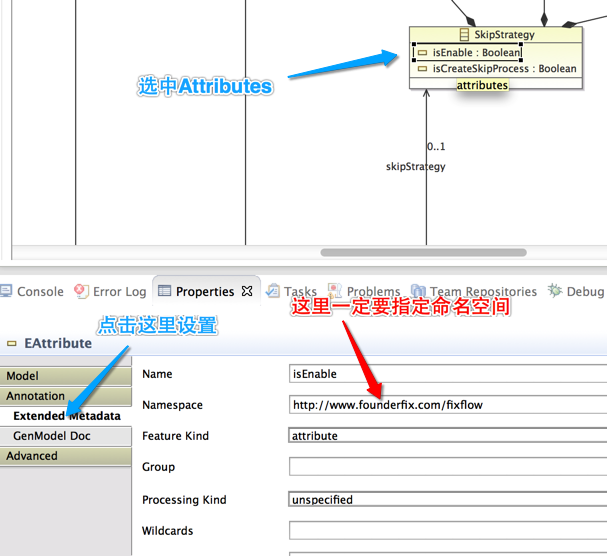| Fixflow引擎解析(四)(模型) - 通过EMF扩展BPMN2.0元素 |
| Fixflow引擎解析(三)(模型) - 创建EMF模型来读写XML文件 |
| Fixflow引擎解析(二)(模型) - BPMN2.0读写 |
| Fixflow引擎解析(一)(介绍) - Fixflow开源流程引擎介绍 |
我们在第一章中介绍了怎么通过EMF读写BPMN2.0官方元素,
第三章中介绍了怎么建立一个简单的EMF模型来读写XML,
在这章里边我们介绍下怎么给BPMN2.0模型注入扩展元素。
1.为什么需要扩展
由于BPMN2.0官方提供的标准不能满足一个引擎需要运行起来的所需的一些元素,所有各个基于BPMN2.0标准的厂商都对BPMN2.0标准进行了自己的扩展。
例如:
activiti引擎的扩展都是以"activiti:"开头的
1 <serviceTask id="javaService" 2 name="Java service invocation" 3 activiti:class="org.activiti.examples.bpmn.servicetask.ToUpperCaseFieldInjected"> 4 <extensionElements> 5 <activiti:field name="text" stringValue="Hello World" /> 6 </extensionElements> 7 </serviceTask>
fixflow引擎的扩展都是以"fixflow:"开头的
1 <bpmn2:userTask id="UserTask_1" fixflow:taskType="FIXFLOWTASK" name="人工任务"> 2 <bpmn2:extensionElements> 3 <fixflow:assignPolicyType id="potentialOwner"/> 4 <fixflow:skipStrategy/> 5 <fixflow:taskCommand id="HandleCommand_3" name="提交" commandType="submit"/> 8 <fixflow:expectedExecutionTime/> 9 <fixflow:formUri> 10 <fixflow:expression xsi:type="fixflow:Expression" id="Expression_3">DemoServlet?action=startOneTask</fixflow:expression> 11 </fixflow:formUri> 12 </bpmn2:extensionElements> 13 <bpmn2:incoming>SequenceFlow_1</bpmn2:incoming> 14 <bpmn2:outgoing>SequenceFlow_3</bpmn2:outgoing> 15 <bpmn2:potentialOwner id="PotentialOwner_1" fixflow:resourceType="user" fixflow:includeExclusion="INCLUDE"name="所有人"> 16 <bpmn2:resourceAssignmentExpression id="ResourceAssignmentExpression_1"> 17 <bpmn2:formalExpression id="所有人">"fixflow_allusers"</bpmn2:formalExpression> 18 </bpmn2:resourceAssignmentExpression> 19 </bpmn2:potentialOwner> 21 </bpmn2:userTask>
每个引擎的厂商都会对BPMN2.0官方元素做出扩展,这就导致了流程定义虽然可以在不同的流程产品相互显示,但是想运行起来是不可能的。
2.BPMN2.0官方关于扩展元素的支持
可以看到BPMN2.0官方已经提供了扩展元素的存放位置:
1 <bpmn2:userTask id="UserTask_1" fixflow:taskType="FIXFLOWTASK" name="人工任务"> 2 <bpmn2:extensionElements> 3 <fixflow:assignPolicyType id="potentialOwner"/> 4 <fixflow:skipStrategy/> 12 </bpmn2:extensionElements> 13 </bpmn2:userTask>
"extensionElements" 元素内就用来存放各个厂商自己扩展的元素,"fixflow:"开头的 attribute 就是官网元素本身的属性扩展,
官方也是清楚的,他们给的那点肯定是不够用的,所以就有了上面的扩展,3.0出来了肯定会提供更多支持。
3.扩展 BPMN2.0 EMF模型的思路
Fixflow在读写BPMN2.0模型的时候使用了Eclipse官方提供的EMF模型,扩展元素的最好的方式就是不修改原始Eclipse提供的模型,
采用外部注入的方式修改给EMF模型添加新的元素。我们需要重新建立一个EMF模型来放置Fixflow引擎自己扩展的元素定义,
通过EMF提供的注入方法添加到元素的模型保存中去,下面我们一步步来完成这个过程。
4.创建一个EMF模型
这里我们不再详细介绍创建模型文件的过程,不清楚的请参考第三章创建模型。
下面的截图是 fixflow 的扩展元素模型:

这个扩展模型有些需要注意的地方,模型 整体的 Ns Prefix 和 Ns URI 这个两个属性决定了你扩展元素的名称和命名空间。

Attributes 的设置需要注意的事项。

EReference 引用设置需要主要的地方。

创建完毕生成三个模型文件,并生成对应java代码。

5.读写扩展元素
下面的代码就是在web环境下读写BPMN2.0模型扩展元素的代码:
模型文件下载地址: SampleProcess.bpmn.7z
1 import java.util.List; 2 3 import org.eclipse.bpmn2.BaseElement; 4 import org.eclipse.bpmn2.Bpmn2Factory; 5 import org.eclipse.bpmn2.Bpmn2Package; 6 import org.eclipse.bpmn2.Definitions; 7 import org.eclipse.bpmn2.ExtensionAttributeValue; 8 import org.eclipse.bpmn2.RootElement; 9 import org.eclipse.bpmn2.di.BpmnDiPackage; 10 import org.eclipse.bpmn2.util.Bpmn2ResourceFactoryImpl; 11 import org.eclipse.dd.dc.DcPackage; 12 import org.eclipse.dd.di.DiPackage; 13 import org.eclipse.emf.common.util.URI; 14 import org.eclipse.emf.ecore.EPackage; 15 import org.eclipse.emf.ecore.EReference; 16 import org.eclipse.emf.ecore.impl.EStructuralFeatureImpl.SimpleFeatureMapEntry; 17 import org.eclipse.emf.ecore.resource.Resource; 18 import org.eclipse.emf.ecore.resource.ResourceSet; 19 import org.eclipse.emf.ecore.resource.impl.ResourceSetImpl; 20 import org.eclipse.emf.ecore.util.FeatureMap; 21 22 import com.founder.fix.bpmn2extensions.fixflow.ConnectorInstance; 23 import com.founder.fix.bpmn2extensions.fixflow.FixFlowFactory; 24 import com.founder.fix.bpmn2extensions.fixflow.FixFlowPackage; 25 26 27 public class test { 28 29 public static void main(String[] args) { 30 //创建资源集 31 ResourceSet resourceSet = getResourceSet(); 32 //创建资源 33 Resource resource = resourceSet.createResource(URI.createURI("SampleProcess.bpmn")); 34 35 36 try { 37 //加载资源 38 resource.load(null); 39 } catch (Exception e) { 40 e.printStackTrace(); 41 } 42 //获取根元素 43 Definitions definitions = (Definitions) resource.getContents().get(0).eContents().get(0); 44 //获取process对象 45 org.eclipse.bpmn2.Process process=null; 46 for (RootElement rootElement : definitions.getRootElements()) { 47 if (rootElement instanceof org.eclipse.bpmn2.Process) { 48 process = (org.eclipse.bpmn2.Process) rootElement; 49 } 50 } 51 52 if(process==null){ 53 return; 54 } 55 56 //设置扩展 EAttribute fixflow:dbid 57 process.eSet(FixFlowPackage.Literals.DOCUMENT_ROOT__DBID, "SampleProcess_1"); 58 //读取扩展 EAttribute fixflow:dbid 59 process.eGet(FixFlowPackage.Literals.DOCUMENT_ROOT__DBID); 60 61 62 ConnectorInstance connectorInstance=FixFlowFactory.eINSTANCE.createConnectorInstance(); 63 //添加扩展元素 64 addExtensionElement(process,FixFlowPackage.Literals.DOCUMENT_ROOT__CONNECTOR_INSTANCE,connectorInstance); 65 //读取扩展元素 66 getExtensionElementList(ConnectorInstance.class,process,FixFlowPackage.Literals.DOCUMENT_ROOT__CONNECTOR_INSTANCE); 67 68 69 } 70 71 /** 72 * 创建资源集 73 * @return 74 */ 75 private static ResourceSet getResourceSet() { 76 77 //以下的方式是脱离Eclipse环境在web下使用EMF的时候使用的方式,Eclipse里使用要简单的多。 78 79 ResourceSet resourceSet = new ResourceSetImpl(); 80 (EPackage.Registry.INSTANCE).put("http://www.omg.org/spec/BPMN/20100524/MODEL", Bpmn2Package.eINSTANCE); 81 //注意这里的注册没有这个注册是没有办法通过直接获取扩展元素的 82 (EPackage.Registry.INSTANCE).put("http://www.founderfix.com/fixflow", FixFlowPackage.eINSTANCE); 83 (EPackage.Registry.INSTANCE).put("http://www.omg.org/spec/DD/20100524/DI", DiPackage.eINSTANCE); 84 (EPackage.Registry.INSTANCE).put("http://www.omg.org/spec/DD/20100524/DC", DcPackage.eINSTANCE); 85 (EPackage.Registry.INSTANCE).put("http://www.omg.org/spec/BPMN/20100524/DI", BpmnDiPackage.eINSTANCE); 86 FixFlowPackage.eINSTANCE.eClass(); 87 FixFlowPackage xxxPackage = FixFlowPackage.eINSTANCE; 88 EPackage.Registry.INSTANCE.put(xxxPackage.getNsURI(), xxxPackage); 89 Bpmn2ResourceFactoryImpl ddd = new Bpmn2ResourceFactoryImpl(); 90 //注意这里的注册没有这个注册是没有办法通过直接获取扩展元素的 91 Resource.Factory.Registry.INSTANCE.getExtensionToFactoryMap().put("fixflow", ddd); 92 resourceSet.getResourceFactoryRegistry().getExtensionToFactoryMap().put("bpmn", ddd); 93 resourceSet.getPackageRegistry().put(xxxPackage.getNsURI(), xxxPackage); 94 Resource.Factory.Registry.INSTANCE.getExtensionToFactoryMap().put("bpmn", ddd); 95 return resourceSet; 96 } 97 98 /** 99 * 读取扩展元素 Element 100 * @param t 扩展元素的java类型 101 * @param baseElement 主元素 102 * @param eReference 引用 103 * @return 104 */ 105 @SuppressWarnings("unchecked") 106 public static <T> List<T> getExtensionElementList( Class<T> t ,BaseElement baseElement,EReference eReference){ 107 108 //BPMN2.0官方定义每个BaseElement元素都含有扩展元素ExtensionValues 109 if (baseElement.getExtensionValues().size() > 0) { 110 for (ExtensionAttributeValue extensionAttributeValue : baseElement.getExtensionValues()) { 111 FeatureMap extensionElements = extensionAttributeValue.getValue(); 112 Object objectElement = extensionElements.get(eReference, true); 113 if (objectElement != null) { 114 115 List<T> tObjList = (List<T>) objectElement; 116 return tObjList; 117 118 119 } 120 } 121 } 122 123 124 return (List<T>)null; 125 } 126 127 /** 128 * 添加扩展元素 129 * @param baseElement 主元素 130 * @param eReference 引用 131 * @param o 扩展元素对象 132 * @return 133 */ 134 public static boolean addExtensionElement(BaseElement baseElement,EReference eReference,Object o){ 135 final FeatureMap.Entry extensionElementEntry = new SimpleFeatureMapEntry((org.eclipse.emf.ecore.EStructuralFeature.Internal) eReference, o); 136 if(baseElement.getExtensionValues().size() > 0){ 137 baseElement.getExtensionValues().get(0).getValue().add(extensionElementEntry); 138 }else{ 139 ExtensionAttributeValue extensionElement = Bpmn2Factory.eINSTANCE.createExtensionAttributeValue(); 140 extensionElement.getValue().add(extensionElementEntry); 141 baseElement.getExtensionValues().add(extensionElement); 142 } 143 return false; 144 } 145 146 }